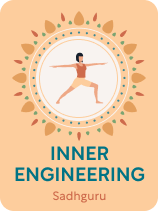

This article is an excerpt from the Shortform book guide to "Inner Engineering" by Sadhguru. Shortform has the world's best summaries and analyses of books you should be reading.
Like this article? Sign up for a free trial here.
Did you know that practicing yoga can help you transcend the mind and access a higher form of intelligence? What is the difference between “knowledge” and “knowing”?
According to yogi master Sadhguru, our body stores great intelligence, and we can access it through the practice of yoga. Through yoga, we can discover our true purpose and break free from the illusion of separateness.
Here’s how your body can become a gateway to a mystical experience of oneness through the practice of yoga.
Intelligence Is Stored in the Body
Your body runs automatically and is in a constant process of creation. We don’t need to tell our lungs to breathe, our hearts to beat, or our hair to grow. But Sadhguru says that rather than experiencing our bodies’ processes unconsciously, we should consciously observe them so we can feel the miracle of creation working within us.
Sadhguru says that intelligence is not just in our minds—it’s also stored in our bodies. He distinguishes between “knowledge” as accumulated information, and “knowing,” which he describes as the dynamic intelligence of life. Everything living is imbued with knowing. Every cell in your body is intelligent—they operate without you ever having to think a thought. Think about how birds instinctively know how to migrate thousands of miles at the right time of year, or how spiders know how to craft exquisitely detailed webs. How do they know how to do those things? This knowing, Sadhguru says, is not stored in their minds; it’s stored in their bodies. And he says that our bodies also have this kind of knowing stored within them—the information about our purpose and how to fulfill it.
Our bodies know on a deeper level how to achieve a higher state of consciousness through connecting to the intelligence of the universe. But we tend to not recognize it, to not be in touch with it, because of the problems discussed in Part 1 of this guide. This is why it’s crucial that we learn to listen to and honor our bodies, Sadhguru says. Practicing yoga is a process of recreating your body so it can serve its highest purpose, transcending the mind and connecting you with the higher intelligence of the universe. Yoga enhances and expands your perception of life beyond the five outward senses. This vastly enriches your experience of life.
(Shortform note: Although those in the modern Western world typically understand brains as being the sole source of intelligence and emotions, many human cultures have believed the heart to be the seat of intelligence and wisdom. Studies show that neither of these notions is totally correct or incorrect. It has been demonstrated that there is a complex bidirectional relationship between the heart and the brain, and the heart actually sends more information to the brain than vice versa. These studies have also concluded that emotional experiences can be stored in the heart, including the ability to sense and respond to environmental changes.)
Because the body is the vehicle for your material existence, Sadhguru explains, keeping it in its optimal state is necessary for your mind and energy to function at their optimal states. Therefore, yoga includes consciousness around diet. Food is important in yogic practice because:
- Your body is made of it. We literally are what we eat, in the sense that every component of your body is created from the materials it gets from the food you eat.
- How you consume and digest food affects the functioning of your body and mind and ultimately your whole experience of life.
There are no moral judgments around food in yogic philosophy, according to Sadhguru. Yoga simply requires eating what’s most conducive to the functioning of our bodies, which he says is a plant-based diet of unprocessed foods. For example, he emphasizes that although meat consumption is discouraged for a yoga practitioner, this is not based in morality. It’s because animal products and processed “junk” foods don’t provide the optimal energy, nutrition, and digestive conditions for your body. As your body consciousness increases with yoga practice, he says you’ll instinctively know what to eat.
(Shortform note: Although Sadhguru personally doesn’t make any moral judgments around diet, some do exist within the yogic Hindu and Buddhist traditions. Ahimsa is a key principle in yoga that emphasizes non-harm or non-violence toward all living beings. Many yoga practitioners interpret this principle as requiring a vegetarian or vegan diet, as consuming meat involves harm or violence toward animals. For this reason, some yoga practitioners choose to follow a vegetarian or vegan diet as part of their spiritual practice.)

———End of Preview———
Like what you just read? Read the rest of the world's best book summary and analysis of Sadhguru's "Inner Engineering" at Shortform.
Here's what you'll find in our full Inner Engineering summary:
- An introduction to the science of yoga and its transformative powers
- Renowned yogi Sadhguru's journey of self-discovery
- Why yoga is not meant to be an exercise or a way to get "fit"






